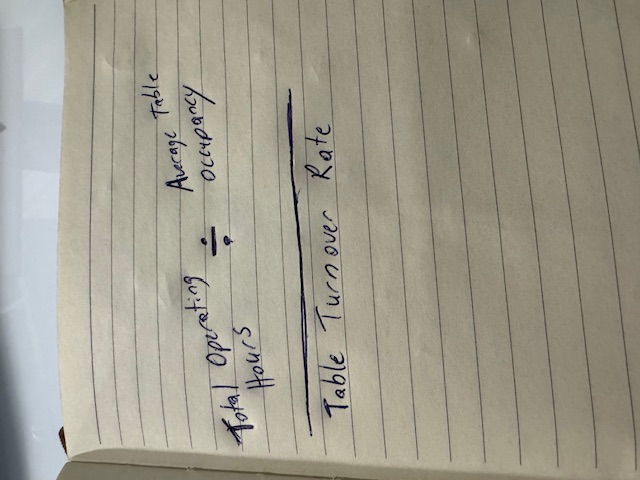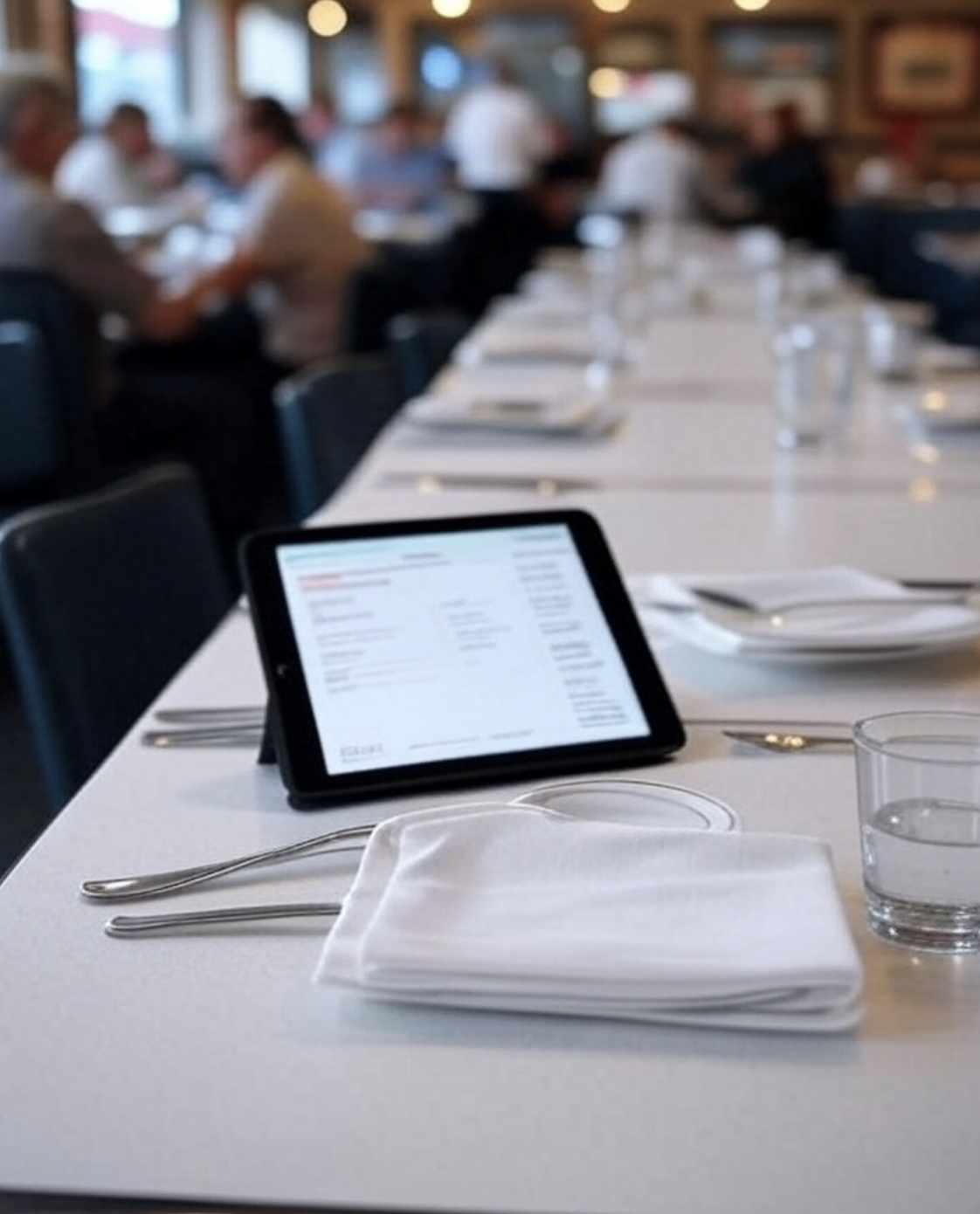Table Turnover Rate Calculator
Find out how many times each table turns during service and identify ways to increase revenue without sacrificing customer experience.
Table Turnover Calculator
Calculate your restaurant's table turnover rate to optimize seating efficiency and maximize revenue. Enter your restaurant's details below to analyze performance.
How to Use the Table Turnover Calculator
This calculator helps restaurant owners and managers measure seating efficiency and identify revenue opportunities. By understanding your table turnover rate, you can make informed decisions about service speed, staffing, and customer flow.
- Enter your seating capacity - Input the total number of seats in your restaurant.
- Add covers served - Enter the number of customers served during the selected period.
- Input average check amount - Enter the average amount spent per customer.
- Select meal period - Choose the specific meal period you're analyzing. Each meal period has different target turnover rates based on typical dining durations. Whether you're measuring a 2-hour lunch rush or a 4-hour dinner service, select the appropriate period to get accurate benchmarks for your analysis.
- Calculate results - Click the "Calculate Table Turnover Rate" to see your turnover rate and revenue metrics.
- Review insights - Analyze the results including turnover rate, total revenue, and revenue per seat based on the metrics you entered.
The calculator will also compare your results to industry standards and provide tips to improve your turnover rate while keeping diners happy.

Why Table Turnover Matters for Restaurant Revenue
Table turnover is important because it impacts revenue for sit-down restaurants and even fast-food or quick-serve restaurants to a certain degree. Not everyone wants to go through the drive-through to eat or have food delivered. Sometimes it's nice to sit down, have a proper meal at a restaurant when the food is freshest. You don't need to worry about cleanup either because all that is taken care of. It's also nice to be served, get refills on water or whatever you're drinking.
How Table Turnover Impacts Restaurant Revenue
Table turnover directly impacts restaurant revenue by determining how many customers can be served in a given time period. Higher table turnover means more customers can be seated, leading to increased sales from food and beverages. For example, if a restaurant has 20 tables and an average check of $50 per table, turning tables once per hour versus twice per hour could double revenue from $1,000 to $2,000 in that hour, assuming consistent demand.
"Serving food faster isn't just about efficiency. It's about making more money and keeping customers happy," says Mark Hamilton, owner of Mark's Grill based in Memphis.
Seeing the benefits of table turnover depends on several factors that you need to keep in mind. You can't operate in a vacumm with this metric and expect to see higher profit.
- Demand: High turnover only boosts revenue if there's a steady flow of customers waiting to be seated. In low-demand periods, faster turnover may not translate to more sales.
- Customer Experience: Rushing customers to increase turnover can lower satisfaction, reduce tips, and discourage repeat visits, potentially hurting long-term revenue.
- Table Size and Pricing: Turnover on larger tables or higher-spending parties (e.g., groups ordering drinks or multi-course meals) has a bigger revenue impact than on smaller, lower-spending ones.
- Operational Efficiency: Staff efficiency, kitchen speed, and reservation systems influence how quickly tables can turn without compromising service quality.
Balancing turnover with customer experience is key. Strategies like streamlining service, optimizing seating arrangements, or encouraging reservations during peak times can maximize turnover while maintaining satisfaction. Conversely, overemphasizing turnover at the expense of ambiance or service can erode revenue over time by alienating customers.
Key Formulas Used in Table Turnover Calculations
Core Calculations
Table Turnover Rate = Covers Served ÷ Seating Capacity
This formula calculates how many times each seat is occupied during the measured period. A higher rate indicates more efficient seat utilization.
Total Revenue = Covers Served × Average Check Amount
Calculates the total revenue generated based on the number of customers served and their average spending.
Revenue per Seat = Total Revenue ÷ Seating Capacity
Shows the average revenue generated by each seat in your restaurant, helping identify efficiency opportunities.
Utilization Rate = (Covers Served ÷ (Seating Capacity × Target Turnover)) × 100
Measures how well you're utilizing your seating capacity compared to industry benchmarks for your meal period.

Table Turnover Rates by Meal Period
| Meal Period | Average Dining Time | Target Turnover Rate |
|---|---|---|
| Breakfast | 30-45 minutes | 3-4 times |
| Lunch | 45-60 minutes | 2-3 times |
| Dinner | 60-90 minutes | 1.5-2 times |
| Fine Dining | 90-120 minutes | 1-1.5 times |
Tips for Optimizing Table Turnover
I spoke with restaurant consultant John Knight who worked with Chipotle from 2009-2011 about this subject. "Typically our approach is to start right from the menu," Knight explained. "Then work to the service model and how we can get the customer the best food possible for the best service time."
Knight emphasized the importance of customer flow, particularly in fast-casual settings. "And get through puts, especially in the fast-casual market and the food-truck market, the secret is to keep the customers flowing through. Especially as you only have two hours to make 80%+ of your business, which is the lunch crowd."
His advice is succinct: "Keep tables turning and guests satisfied to fuel the bottom line." Knight also shared practical implementation strategies: "Streamline the payment process with tableside tablets to boost table turnover."
- Streamline your menu - A focused menu reduces decision time and kitchen preparation time. As Mark Hamilton noted, "The fewer items you have, the faster you can prepare and cook."
- Train staff efficiently - Well-trained servers can manage multiple tables and expedite service without making customers feel rushed. "It's all about muscle memory," Hamilton says. "Repetition creates speed, and speed creates more orders. The fewer items you have, the faster you can prepare and cook."
- Use technology - Digital ordering systems and payment processing can reduce wait times. John Knight specifically mentioned tableside tablets as a game-changer.
- Optimize table layouts - Proper spacing and table sizes can improve flow and capacity utilization.
- Manage reservations strategically - Stagger seating times to avoid bottlenecks. Consider time limits for peak periods. This is another strategy I picked up as a waiter working with a host or hostess. No server can wait on everyone at the same time when there are 3 at once.
- Pre-bus tables - Clear dishes as customers finish courses to speed up table turnover without rushing diners. This is one I learned while waiting tables back in the day. It works!
From my own experience, I worked at restaurants all through college as a server and also appreciated quick restaurant turnover as well. The more people I could sit down and serve at my set of tables, the more money I would make in tips. There's nothing worse as a server than standing around without tables, because you aren't making money either.
Related Restaurant Management Tools
- Restaurant Seating Capacity Calculator - Find out the number of seats you can comfortably add to a restaurant based on size.
- Restaurant Valuation Calculator - Use this calculator to find the estimated value of the business if you decide to sell. Warning: Restaurants suffer from abysmal valuations.
Final Thoughts
The key to successful table turnover optimization is finding the sweet spot between efficiency and customer satisfaction. As Knight advised, you need to "keep tables turning and guests satisfied to fuel the bottom line." Use this calculator regularly to monitor your performance and identify opportunities for improvement without sacrificing the dining experience that keeps customers coming back.
